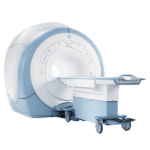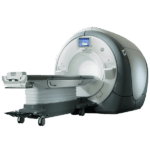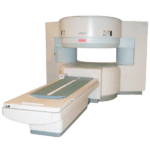Like most products on the market, MRI scanners are not all the same, nor are they manufactured by the same company
Like most products on the market, MRI scanners are not all the same, nor are they manufactured by the same company. The most common top name brands for MRI scanners are Philips, Hitachi, Siemens and GE. Types of MRI scanners can also be differentiated by their magnetic field strength or tesla (T), and by construction or orientation such as open, closed or upright. A closed machine is a smaller, narrower tube and provides the best images. An open MRI machine is open on three sides, making it more comfortable for the patient. The upright MRI is very useful when the physician needs to see the effects of weight bearing on the body.
High-field MRI Scanners. High-field MRI scanners, typically identified as closed MRI scanners, are the preferred type for physicians. These scanners use a magnet strength that can range from 0.5T up to 3.0T. A 1.5T provides great image quality, fast scan times, and the capability to evaluate how certain structures in the body function. The 3.0T MRI scanner, double the strength of the 1.5T, is ideal for visualizing very fine detail such as brain and heart vessels. However, these closed machines can be uncomfortable for claustrophobic patients and can only handle patients who weigh no more than three hundred pounds.
Low-field MRI Scanners. Low-field MRI scanners, typically known as open MRI scanners, have a range of 0.2T-0.5T. With an open MRI, scanners have decreased image
quality since the magnet is not traveling around the whole body, and require a longer scan time compared to high-field MRI scanners. Open MRI machines are not meant to perform high end applications. These scanners are especially useful for people who are claustrophobic or unable to have a closed MRI scan due to weight restrictions or body circumference. It has also been used as a marketing tool for hospitals, physicians, and imaging centers with the intention to attract additional patients and referring doctors.
Standup/Upright MRI Scanners. Stand-Up MRI scanners are useful for those who are unable to lie down or who have conditions where the body part needs to be visualized while standing, bending, or sitting. This type of scanner is best used for the spine and joints, where weight-bearing is necessary. It is also beneficial for those who suffer from claustrophobia, and in some cases, has the capability to perform flexion and extension studies.
Get Started
Request Pricing Today!
We’re here to help! Simply fill out the form to tell us a bit about your project. We’ll contact you to set up a conversation so we can discuss how we can best meet your needs. Thank you for considering us!
Great support & services
Save time and energy
Peace of mind
Risk reduction
MRI MAGNETS
The biggest and most important component in an MRI system is the magnet, and the strength of the magnet is vital. A homogeneous magnetic field of incredible strength and stability is critical for high-quality imaging. There are three basic types of magnets used in MRI systems:
Resistive magnets consist of many windings or coils of wire wrapped around a cylinder (or bore) through which an electric current is passed. This generates a magnetic field, which will die out if the electricity is shut off. These magnets are lower in cost to construct, but require a tremendous amount of electricity to operate because of the natural resistance of the wire. The electricity can get expensive when higher power magnets are needed. To operate this type of magnet above the 0.3-tesla level would be quite costly.
Permanent magnets are just that…permanent. Its magnetic field is always there and always on full strength, so maintaining the field requires no cost. The major drawback is that these magnets are extremely heavy – up to several tons. A stronger field would require a magnet so heavy it would be difficult to construct. Though permanent magnets are getting smaller these days, they are still limited to low field strengths.
Superconducting magnets are by far the most commonly used in MRI systems. They are similar to resistive magnets in that the coils of wire with a passing current of electricity create the magnetic field. The important difference is that in a superconducting magnet, the wire is continually bathed in liquid helium at 452.4 degrees below zero. (Yes, patients are surrounded by a substance that cold! Of course it is very well insulated by a vacuum.) This unbelievably cold temperature causes the resistance in the wire to drop to zero, dramatically reducing the electrical requirement for the system and making it much more economical to operate. Superconductive systems are still very expensive, but they can easily generate 0.5T to 2.0T fields, allowing for much higher-quality imaging.
Another type of magnet found in every MRI system is called a gradient magnet. There are three gradient magnets inside the MRI machine, which are extremely low strength compared to the main magnetic field. The main magnet immerses the patient in a stable and very intense magnetic field, and the gradient magnets create a variable field. They are arranged in a particular style inside the main magnet so when they are rapidly turned on and off in a specific manner, they alter the main magnetic field. What this means is that you can pick exactly which area you want a picture of, and the machine does not need to be moved around to get an image from a different direction, the machine can manipulate everything with the gradient magnets.
If you have questions about MRI scanners or need help choosing the right type of MRI, give me a call! We also have GE MRI machines for sale, Philips MRI machine for sale, and Hitachi MRI machine for sale. I look forward to helping you find the right equipment to make your business grow!
Posted by:
Bobby Serros
MRI, CT & PET/CT Specialist
References:
http://www.sharecare.com/question/what-types-magnets-mris-use
http://www.livestrong.com/article/96879-types-mri-machines/
http://www.ehow.com/about_4686615_types-mri-machines.html



